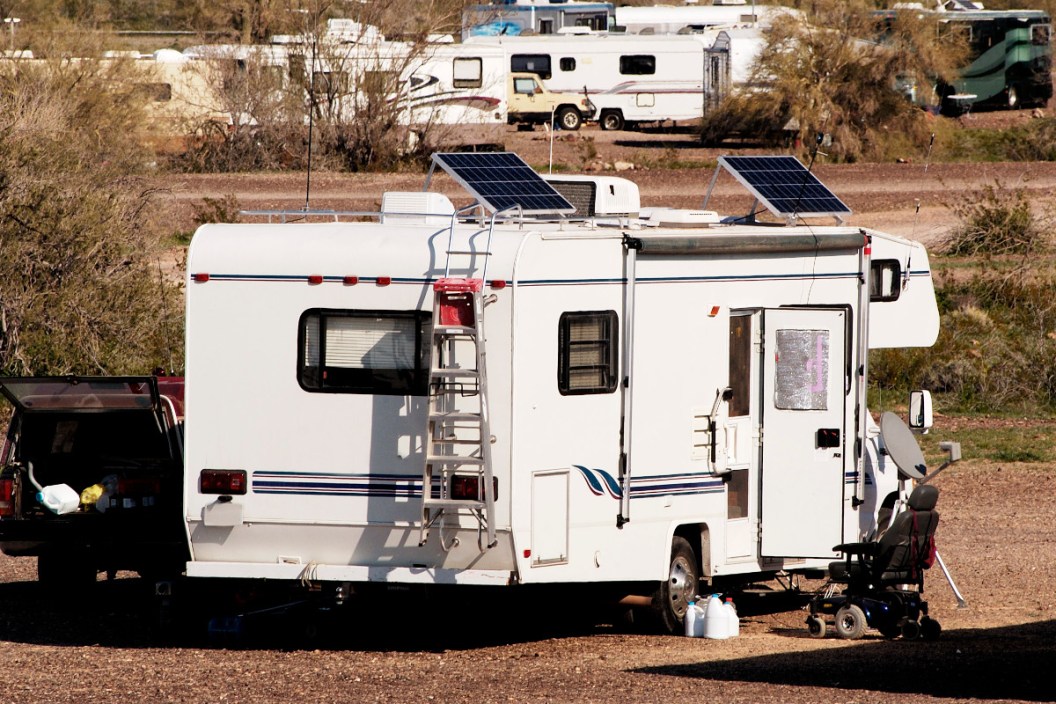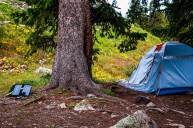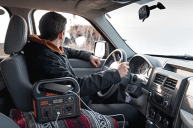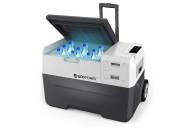As much as we love getting away from it all when we head into the outdoors, there's something to be said about having all the modern comforts of home when you're in an RV or camper. Until recently, that meant paying more costly fees for full hook-ups at a modern campground, or splurging for a large generator. While these generators provide all the power you might need, they come with the downsides of costly gasoline costs and worse, a noise factor that ruins the peace and serenity we were pursuing in the wilderness in the first place. In fact, many campgrounds are now putting generator restrictions in place that force you to plug in to their modern full hook-ups (in more expensive campsites) or go without power completely for the duration of your stay. Knowing that, it's little wonder the new off-grid solution to power for campers is a move towards solar systems. For many campers, harnessing the raw energy of the sun to provide a free source of RV power is a quite tempting one. But before you go investing in an expensive solar panel system, it's worth looking at solar power a little more in-depth. Because if we're being honest, for some people, this system might not fit all their power needs, at least not without a significantly high investment. Let's take a closer look at solar power and exactly what solar can and cannot do to help you go off the grid permanently for your next camping adventure.
What solar panels actually do.
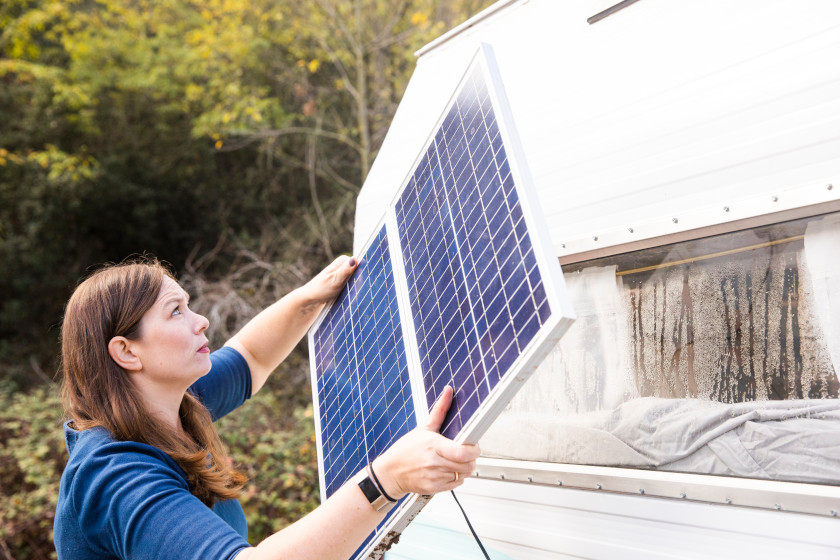
Getty Images: adamkaz
Solar can be quite confusing, so we're going to break it down as simply as we can. The main thing to understand is that solar panels do not power your RV or electronics. The only thing solar panels do is gather raw energy from the sun which is then stored in RV batteries for use later. The more panels you have, the faster the batteries will replenish themselves and the more electronic equipment you can use.
One thing we need to make it clear is that your RV's battery doles out power differently than the everyday appliances you want to power like a toaster or a microwave. That's because RV batteries operate on a 12 volt DC current system just like your car or truck.
This means your standard RV battery will give you power. However, it will only allow you to do most things you can already do in your car. If you're an experienced RVer, you already know that means you can listen to the radio, turn on interior lights, and probably use your water pump. Alternatively, if you want to use basic appliances like a TV, hair dryer, or a heater, those all operate on a 110 volt AC current system. Because RV batteries don't convert 12 volt DC to 110 volt AC, you will need an inverter to covert the 12 volt power for use with 110-volt appliances. The larger your inverter, the larger the appliances you can power from the battery can be. We'll get more into this later.
You will also need a solar charge controller. These devices are used to regulate the energy from the panels to the battery. Without a charge controller, the battery could get overcharged, causing damage. This equipment is expensive, so yes, this is something you will need for safe operation. Basically, the charge controller makes sure the battery is charging as efficiently as it can. They also prevent the batteries from losing power during the night when the panels are not in use.
How much solar power does an RV need?
When most people ask this question, they are typically wondering if 100 or 200 watts of solar panels is enough for an RV. The answer is yes, but that also depends on your energy consumption needs and the size and type of battery. For example, the video above gives a good idea of what 200 watts will do. YouTuber Colorado Camperman is using a 200-amp hour Renogy Gel battery with a 20-amp hour charge controller, and a 250-watt inverter with about 200 watts of solar. As he states in the video, it's good for the basics. We're talking about things like a radio, cell phone chargers, and cameras. A setup like this will also usually work for a smaller TV for a short while. It could also work for one of those smaller, dorm-sized mini-fridges for a time. The high draw nature of larger fridges is why most manufacturers make the fridges run on propane, saving you some power there.
However, note that he's using just a 250-watt inverter. That means this setup is not enough for anyone who wants to run the air conditioning, a hair dryer, a toaster, or a coffee maker. If you want to run those things, you're going to need a more extensive battery bank, and likely many more solar panels to keep them topped off.
At the opposite extreme is the man in the video below, who has taken his setup completely off-grid with an extreme solar power system featuring 1,200-amp hours of battery. This setup allows him to run everything in the RV, including three air conditioners simultaneously if he so chooses, although he also notes he cannot do that for very long.
The downside to this guy's setup is the cost and space. The man needed to buy a toy hauler just for the extra space for all those batteries and charge controllers, which are not cheap, even to the point to which he said he'd likely never recoup the costs. It's more about the freedom of being able to go anywhere and do anything without worrying about needing to power up a generator.
However, that's an extreme case. For our main purposes, we'll just assume power needs for an average user, like someone who maybe takes several short weekend camping trips and one long road trip a year. Maybe they spend one or two nights boondocking in a Walmart parking lot between destinations and they just want to run the basics mentioned earlier, and perhaps watch a little TV before bed. RVers with those needs should find 200 watts of solar more than adequate.
In truth, it's not the panels that affect how much you can do so much as the size of the inverter and the amount of battery power you have. The panel just affects how quickly they will recharge. Most RVers these days are finding a sweet spot between two and four 100-watt panels. Don't forget to take RV roof space into account too. A smaller 14-foot travel trailer is going to have significantly less space for solar installation than a 50-foot Class A motorhome.
How to calculate how many panels you'll need.
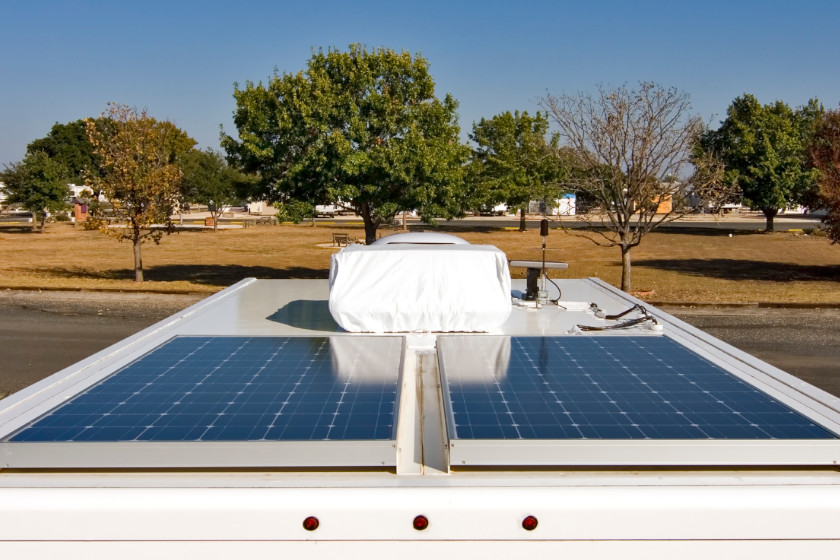
Getty Images: Photosbyjam
As you can see, there's no easy answer to how many panels you'll need. Some people can get away with one or two just fine. Others are going to need way more.
Luckily, there are ways to calculate how many solar panels you'll need, but it can get rather complicated and confusing. Battle Born Batteries does a nice job of explaining it simply.
"A good rule-of-thumb is that a 100-watt solar panel will generate about 30 amp-hours (approximately 350 watt-hours per day. With this in mind, you can take your daily energy consumption and divide it by 350 to get an estimate of how many 100-watt solar panels you need."
For example, let's assume you're using around 1,500-watt hours per day. That means you'll need at least four solar panels. Keep in mind this is not a perfect science! Just because a panel is 100 watts does not mean it's going to gather exactly 100 watts constantly for eight hours a day every day. Clouds or other bad weather can interrupt how fast your batteries change with a solar panel. If you're in an area that's cloudy all the time, that means your RV solar energy production will be a lot slower than someone in a place with constant sunshine.
If you want to get more technical on determining your needs, Renogy has a rather sophisticated solar calculator to help determine exactly what you'll need based on your batteries, your inverter, the number of panels, and even where you plan to spend most of your time. Obviously, it recommends their brand of batteries, but you can assume similar performance for other brands when you're off-grid.
Remember that with solar, you can keep adding batteries and panels until you've got enough for your specific power needs. For average RV users, we recommend starting with two to four panels and then taking some dry runs camping somewhere locally off the grid. This will give you an even better idea of how much power you use each day. Monitor your power use closely and you can make adjustments from there to your solar setup that fit your specific camping style.
For more outdoor content from Travis Smola, be sure to follow him on Twitter and Instagram For original videos, check out his Geocaching and Outdoors with Travis YouTube channels.
READ MORE: 6 BEST PORTABLE SOLAR PANELS FOR YOUR NEXT CAMPING TRIP
